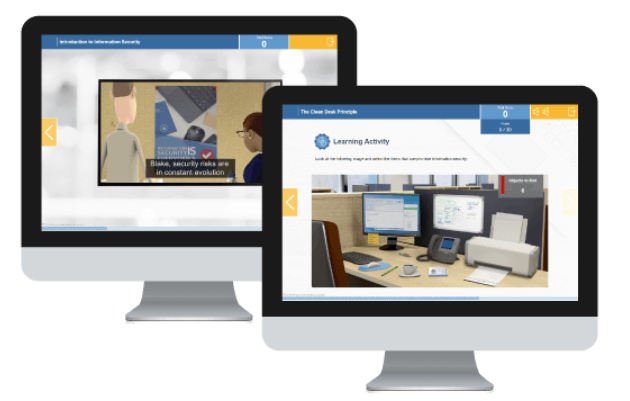Benefits of Cybersecurity Training
Cybersecurity training for employees gives your leadership and IT teams peace of mind by ensuring your organization operates with a security-aware mindset. Reduce risk and stress and give your team the bandwidth to focus on bigger projects.
Human risk management helps organizations to:
 Avoid data breaches and related downtime or financial losses.
Avoid data breaches and related downtime or financial losses.
 Give your customers and partners confidence.
Give your customers and partners confidence.
 Build a culture that prioritizes cybersecurity.
Build a culture that prioritizes cybersecurity.
 Strengthen your cyber attack defenses.
Strengthen your cyber attack defenses.
 Free up IT time to focus on big projects.
Free up IT time to focus on big projects.
Cybersecurity Training Topics
Digital technology's growth has unleashed potent security threats. Merely knowing isn't enough; our targeted courses will equip your employees to actively confront risks, enforce best practices, and fortify our digital defenses.
Compare your phishing performance to global benchmarks
Get the latest Gone Phishing Tournament results.
Fortra Human Risk Management

Fortra is setting a new bar for engaging, informative security training.
Every content module, from in-depth courses on topics like phishing and ransomware, to immersive Cyber Games activities, helps you reduce the human risk factor, strengthen your cyber threat defenses, and keep your confidential information safe from hackers.
No more:
 Inadequate reporting
Inadequate reporting
 Clunky integration
Clunky integration
 Unresponsive support
Unresponsive support
 Boring content
Boring content
Say hello to:
 Comprehensive analytics
Comprehensive analytics
 Easy SaaS implementation
Easy SaaS implementation
 Continuous, expert support
Continuous, expert support
 Hundreds of engaging training modules
Hundreds of engaging training modules
Training Platform Features
Training Platform Capabilities
Get the highest-quality cybersecurity training that provides an engaging, informative eLearning experience.
Fortra offers customizable courses, quizzes, game-style activities, and communication tools that are perfect for any industry, organization size, and security awareness budget.
Boost employee engagement and course completion with gamified content
Improve engagement by up to 90% while driving retention. Motivate users with gamified and proven micro-and-nanolearning techniques.
Improve engagement by up to 90% while driving retention. Motivate users with gamified and proven micro-and-nanolearning techniques.
The best training content, always at your fingertips
Find the right content for your needs in just a few clicks with the easy-to-use ContentHub. Build engaging courses and phishing simulations from hundreds of templates.
Find the right content for your needs in just a few clicks with the easy-to-use ContentHub. Build engaging courses and phishing simulations from hundreds of templates.
Create personalized campaigns
Don’t settle for a one-size-fits-all learning experience. Personalize every aspect of your awareness training program to you attain your behavior change goals.
Don’t settle for a one-size-fits-all learning experience. Personalize every aspect of your awareness training program to you attain your behavior change goals.
Identify high-risk individuals and roles
Reduce risk with data-driven ratings from the Security Culture Index, based on cybersecurity knowledge, access permissions, and more.
Reduce risk with data-driven ratings from the Security Culture Index, based on cybersecurity knowledge, access permissions, and more.
Customizable reports right from your dashboard
Download customizable reports and share your training results with management. Track end user progress, pinpoint and high-risk areas, and measure your program’s performance.
Download customizable reports and share your training results with management. Track end user progress, pinpoint and high-risk areas, and measure your program’s performance.
Easy integration for seamless training deployment
No more clunky integration. No more headaches. Fortra simplifies implementation with full, SaaS-based LMS capabilities that are SCORM-compliant.
No more clunky integration. No more headaches. Fortra simplifies implementation with full, SaaS-based LMS capabilities that are SCORM-compliant.
Support from in-house CISOs and security experts
Leverage over two decades of industry experience and subject matter expertise to help plan and execute a successful security awareness program.
Leverage over two decades of industry experience and subject matter expertise to help plan and execute a successful security awareness program.
Services for Security Awareness
Take the guesswork out of implementing, managing, and optimizing your human risk management program with our managed services option. Knowledgeable, friendly, supportive staff will ensure your training initiatives are successful.
 HRM Advisory Services
HRM Advisory Services
With over 20 years of industry experience, in-house HRM Advisory Services can help you plan and optimize every part of your human risk management program.
Managed HRM Services
Work with a dedicated, knowledgeable, and supportive team to deploy and manage all aspects of your human risk management program, and ensure you attain your security awareness goals.
Free Cybersecurity Training Resources for Employees
Make sure crucial cybersecurity topics and messaging are always top-of-mind with a diverse suite of communication tools. Leverage videos, infographics, specialized blog posts, and more, with new tools added to the inventory regularly.
Videos
Reinforce key awareness concepts and skills through stylish visual storytelling. See sample videos >
Infographics
Translate cybersecurity concepts into fun, concise infographics that are instantly shareable across any internal communication platform.
Blog posts
Go deep on crucial cybersecurity awareness topics with blog posts on phishing, social engineering, strong passwords, and more.
Posters
Promote your training program with visuals you can tailor to match your brand.
Newsletters
Send training updates and security best practice highlights directly to your users.
 The Cybersecurity Hub
The Cybersecurity Hub
Building a security-aware culture shouldn’t be complicated (or pricey). Share cybersecurity best practices with your employees instantly with content kits from the Cybersecurity Hub.
How to Create a Successful Cybersecurity Training Program

The Approach that Fuels Security Awareness Success
Fortra has built your blueprint for success so you don’t have too.
Get step-by-step guidance on how to create a strong awareness training strategy, plan and launch program initiatives, and ensure you’re changing unsafe end user behaviors for the better
The 5-step framework approach to cybersecurity awareness, outlined in the Human Fix to Human Risk, empowers security leaders to:
- Reinforce best practices with the right communication tools
- Leverage gamification to enhance awareness training
- Optimize training effectiveness with real-time, data-driven insights
![]()
Fortra and Microsoft: An industry-leading partnership
"Regarding training, we think that the catalog should be large, diverse, interactive, inclusive, accessible, and localized. Fortra catalog meets all those requirements, which is why we partnered with them."
- Brandon Koeller, Principal Program Manager Lead at Microsoft
Get in touch with us
Want to know more about how we can help you? Have any questions about our products?




